 |
||
|
||
| ||
128 Mb flash MultiMediaCard from Kingston 128 Mbit 450 MHz DDR SGRAM chips from Infineon Summit, Apogee, and Zenith: system cosmetics from Chaintech, part 2 Photo of the day: Matrox Parhelia 512 Two new videocards from Soltek 1 Gb Registered DDR333 SDRAM units from Infineon Chaintech´s motherboard roadmap for AMD processors Intel to test processors with X-ray TDK presented the original "can-like" MediaReader CAN card reader, to be available for sale in August. Besides economic vertical design, the new device features a slot-cover lid.  The novelty supports CF, SM, SD, MMC flash cards and IBM Microdrive devices. The "flash-can" features USB 1.1 interface and is provides functionality of 2-port USB hub. Its size: 64 mm in diameter, 110 mm in height; the weight is 250 gr. Supported operating systems: Windows 98/Me/2000/XP; Mac OS 8. 6/9. X, Mac OS X. The expected price is about $55.
This event is of even more importance for Intel as its role in the chip technology development has largely defined the current acheivements of computer industry. From the Intel 8080, used as a CPU in Altair computer far back in 1974, by Intel 8088 with 4.77 MHz clock rate, that became a base for IBM PC in 1981, to the current 2.53 GHz Pentium 4 — the company processors have made a really long way. Having started humbly, in eleven years in 1982 U.S. News and World Report included Intel´s processor into the list of the 12 most important inventions in the history of USA (along with electric bulb, telephone, and plane).
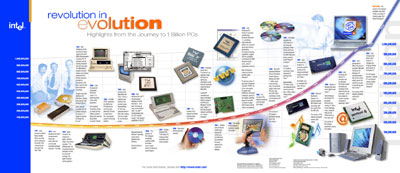 According to Gartner Dataquest analysts, the second-billion level will be reached faster then the previous: calculations show that PC industry will achieve two-billion point already by 2008. If it´s to be true, the nearest years will bring the worldwide sales of about five PCs per second! The buyers of the next billion of PCs are to belong to much wider society strata, that is more than 6.2 billion of people now. We congratulate Intel Corporation as well as all other companies in this industry with the remarkable event; we also congratulate everyone who participated in the first billion of PCs, send our regards to those without computers, and hope they´ll join us in the second billion!
128 Mb flash MultiMediaCard from Kingston Kingston announced mass deliveries of 128 Mb MultiMediaCard (MMC) memories.Miniature (32x24x1.4 mm) MultiMediaCard is a rather popular data storage solution, however they are mostly presented by up to 64 Mb samples on the market. New 128 Mb MultiMediaCard from Kingston provide 1.7/1.6 Mb/s read/write speed. Kingston 128MB MultiMediaCard (MMC/128) have a five-year warranty; the recommended retail price is $116.
128 Mbit 450 MHz DDR SGRAM chips from Infineon Infineon Technologies presented new 128 Mbit DDR Graphics RAM (DDR SGRAM) chips, designed for current graphic cards. They feature high clock rate of 450 MHz, providing up to 3.6 Gb/s performance.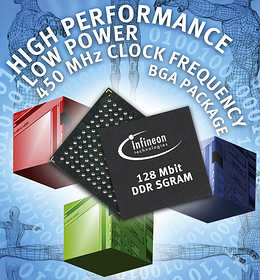 New 128 Mbit Graphics RAM chips feature 1.8 interface, providing higher economy than the standard 2.5 interface. 128 Mbit Graphics RAM are organized as 4íx32 and can be used in graphic solutions with 32-, 64-, 128-, and 256-bit memory interface. Chips are packaged into 144-pin 11x11 mm FBGA casing. The mass production of new 128 Mbit DDR SGRAM 4Mx32 chips with 450 MHz clock rate is planned to the 4Q, 2002. The samples are available now for $9.95 each.
Summit, Apogee, and Zenith: system cosmetics from Chaintech, part 2 Continuing the previous message about Chaintech preparing a new line of nicely packaged motherboards — Summit, Apogee, and Zenith — we present the box design and board samples. 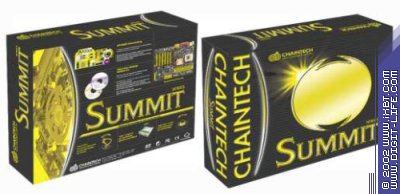  Again, boards feature black PCB with yellow (AMD variant) or green (Intel variant) slots, sockets, ports, and even cables. So, Apogee is designed as Middle-End (round IDE cables, CBOX panel for 3.5" bay featuring 4 USB ports, headphones output, Mic-In, Body Theater headphones). Top-end models are named Zenith and have an additional Firewire port. The Summit series includes inexpensive motherboards without Body Theater headphones and CBOX panel, round IDE cables are also replaced with standard.
Photo of the day: Matrox Parhelia 512 Here we present you the detailed photos of the new Matrox Parhelia 512 videocard, shot in our lab.
Impressive, isn´t it? Hope we´ll review the card in the nearest future to tell you of its performance.
Two new videocards from Soltek Soltek prepares two new graphic cards based on NVIDIA GeForce4 Ti4200 and Ti4600 GPUs. Ti4600-based version features 128 Mb memory and 300/650 MHz core/memory clock rate.
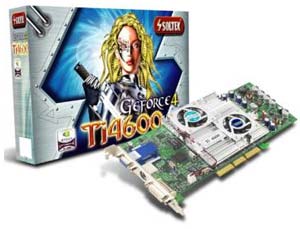 Ti4200-based card has 128 Mb of 650 MHz memory as well, but the core clock rate is 250 MHz. Both of them also feature DVI, TV outputs (S-Video), VIVO capabilities. Deliveries and pricing are still unknown.
To get the idea just follow the pictures. So, that´s folded Flip Pad Voyager below:
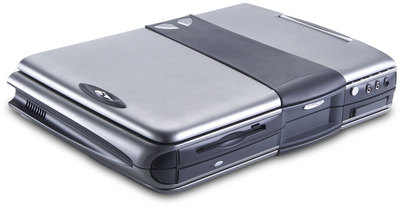 It evolves further being "deployed":
 At last, here´s it ready for action:
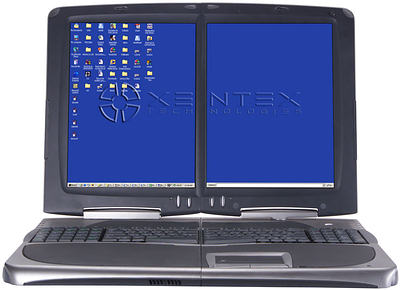 Brief specs of Xentex Flip Pad Voyager:
1 Gb Registered DDR333 SDRAM units from Infineon Today Infineon Technologies presented engineering samples of 1 Gb Registered DIMM DDR333 SDRAM memory units. Samples feature thirty six 256 Mbit chips packaged into FBGA (Fine-Pitch Ball Grid Array) casings and are designed mostly for servers and workstations. New low-profile (1.2" for 1U servers) 184-pin 1 Gb Registered DDR333 units are organized as two banks, 128 Mbit x 72; supply voltage is 2.5 V, signal level — 1.25 V. The samples are available now for the current price of $1300.
Chaintech´s motherboard roadmap for AMD processors The provisional data about Chaintech motherboards for AMD processor platforms is available: For Socket 754 platform
For Socket A platform
Intel to test processors with X-ray Intel has recently decided to use X-ray to bring out finished product defects and improve quality. The new X-ray stand, created by British X-Tek with the direct assistance of Intel´s engineers, creates a 3D X-ray image enabling to reveal defects of new prototypes and optimize interaction of new device components.It took about six years to develop the stand. Having invested into the project about $1.6 million, Intel got the right to purchase the first five such X-ray tools.
 Intel´s quality audit requires over $300 million annually, with more than 2500 engaged specialists worldwide. On the platform design stage they simulate signal spread and synchronization and conduct hard simulations at the component, chip, and entire system levels. After samples are released, they are strictly tested at the system level along with the electrical parameter checking and the comprehensive compatibility tests for over 20 operating systems, 150 peripheral devices and 400 applications. The check includes more than 250 thousand subtests using over 600 software applications. Moreover, Pentium 4 CPUs undergo a trillion (!) of random instruction checks a week. Reference mobile platforms are to pass about 26 thousand hours of additional testing. System checks consist of about 6-8 weeks of round-the-clock usage.
Write a comment below. No registration needed!
|
Platform · Video · Multimedia · Mobile · Other || About us & Privacy policy · Twitter · Facebook Copyright © Byrds Research & Publishing, Ltd., 1997–2011. All rights reserved. |